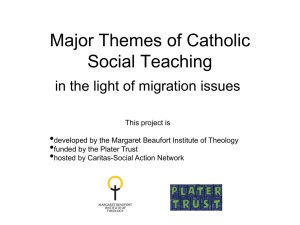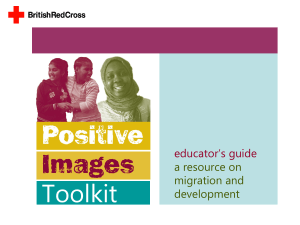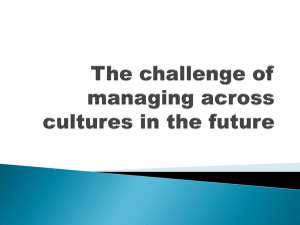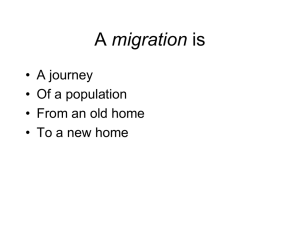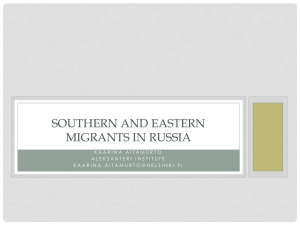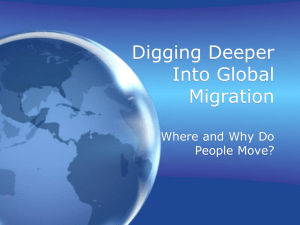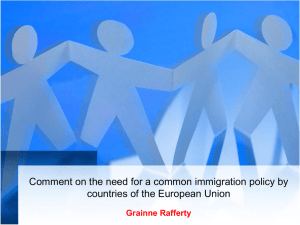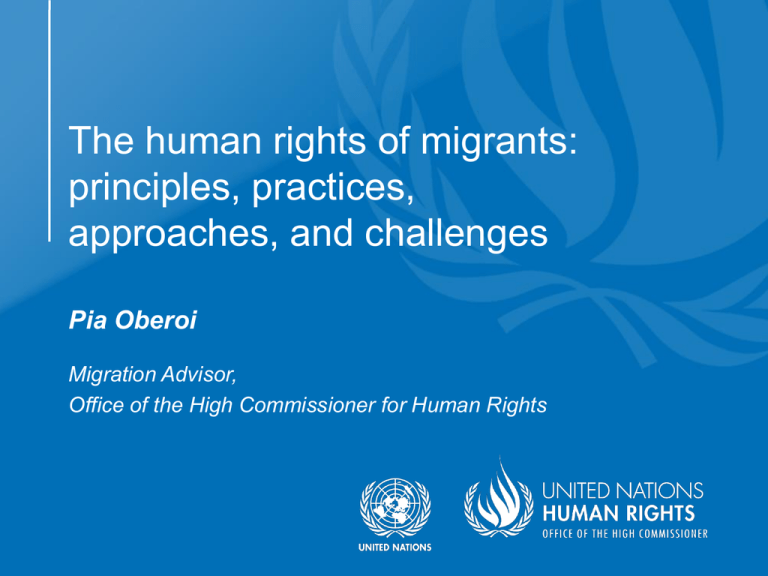
The human rights of migrants:
principles, practices,
approaches, and challenges
Pia Oberoi
Migration Advisor,
Office of the High Commissioner for Human Rights
Structure
What are some challenges
and opportunities of recent
developments in the region?
What are the human rights of
migrants?
What is the human rightsbased approach to migration?
What are some
recommendations for the
High-level Dialogue?
Office of the High Commissioner for
Human Rights
Promoting respect for
human rights is a core
purpose of the United
Nations Charter (peace &
security, development,
human rights)
OHCHR is part of the UN
Secretariat
Supports standard-setting and
monitoring
Conducts research
Assists in human rights
implementation through
technical assistance
Human rights mainstreaming
in the UN system
OHCHR thematic strategy on migration focus
areas
1. Opposing the criminalization of irregular
migrants
2. Combating discrimination, racism, xenophobia,
and related intolerance against migrants
3. Protecting the economic, social and cultural
rights of migrants
4. Advocating for access to safeguards in the
context of immigration detention and to
alternatives to the detention of migrants
5. Protecting human rights in the context of
mixed migration
An “Arab spring» for migrants? Or business
as usual?
The international community should “Support
legislative and institutional reforms to ensure
effective respect for and protection and fulfilment
of the human rights of all migrants, particularly
recognising the previous situation of migrants in
countries of transit and destination in the region.”
OHCHR, Situation of migrants and asylum-seekers fleeing recent events in North
Africa, 2011 (A/HRC/18/54)
Some reflections
Positive recent
developments in
relation to the human
rights of migrants in the
region
Opportunities for wider
legislative and
structural reforms?
But concerns remain …
E.g. Agreement between
Saudi Arabia and the
Philippines on domestic
workers
Regime change based on
concerns about dignity, rights
and social justice could
provide an opportunity for
enhanced attention to
migrants’ human rights.
Including access to services,
labour rights, xenophobia and
discrimination, access to
justice, detention, situation of
irregular migrants, domestic
workers
Migration and the human rights framework
Human rights are intimately connected
with every step of the migration process
All human beings have all human rights;
the framework focuses on the individual
States have voluntarily assumed human
rights obligations
Rights establish a parallel set of duties
and accountability frameworks
Each right has a specific focus and
content
Core international human rights
instruments
•
•
•
•
•
•
•
•
Universal Declaration of Human Rights
International Covenant on Economic, Social and Cultural Rights
International Covenant on Civil and Political Rights*
International Convention on the Elimination of Racial Discrimination
Convention on the Elimination of Discrimination Against Women*
Convention Against Torture*
Convention on the Rights of the Child*
International Convention on the Protection of All Migrant Workers
and Members of their Families
• International Convention for the Protection of All Persons from
Forced Disappearances
• Convention on the Rights of Persons with Disabilities*
* Some treaties are supplemented by optional protocols dealing with
specific concerns
Categories and human rights protection
• General instruments speak to the rights of
«everyone», with few and narrowly defined
exceptions.
• More specific human rights treaties protect their
subjects according to particular characteristics:
women, children, migrant workers, persons with
disabilities.
• Also relevant are instruments that protect refugees
and stateless persons, victims of trafficking,
smuggled migrants …
The risks of excessive categorisation > fragmentation, protection gaps
Universal Declaration of Human Rights (1948)
Recognition of the inherent dignity and of
the equal and inalienable rights of all
members of the human family (Preamble)
All human beings are born free and equal in
dignity and rights (Article 1)
Everyone is entitled to all the rights and
freedoms set forth in this Declaration,
without
distinction of any kind (Article 2)
Everyone
All
human
beings
Non-discrimination
Discrimination constitutes any distinction,
exclusion, restriction or preference or other
differential treatment that is directly or indirectly
based on the prohibited grounds of discrimination
and which has the intention or effect of nullifying
or impairing the recognition, enjoyment or
exercise, on an equal footing, of human rights.
ICRMW grounds: sex, race, colour, language, religion
or conviction, political or other opinion, national, ethnic
or social origin, nationality, age, economic position,
property, marital status, birth or other status
Non-discrimination
The international bill of
human rights allows only
a few limited exceptions
to the principle of equality
between national and
non-nationals, and
between different groups
of non-nationals
Political rights explicitly
guaranteed to citizens
(ICCPR art. 25) *
Freedom of movement
and protections on
expulsion only to
persons lawfully present
in the territory (ICCPR
art. 12(1), 13) *
Limitation in respect of
economic rights to
developing countries
(ICESCR art 2(3)) *
The human rights based approach …
Constitutes a framework of action, as well as a
set of tools for migration policy-makers.
Is based on the international framework of
human rights law as provided in the core
human rights instruments
Upholds the principle of non-discrimination
Establishes accountability between dutybearers and rights-holders
Focuses on vulnerability, marginalisation and
exclusion
Emphasises participation and empowerment
Part VI of the ICRMW: international cooperation to
promote humane migration, taking account of «needs»
of migrant workers
Art. 64(1):
Art. 65(2):
Art. 66:
Art. 67:
• due regard to impact of migration on communities
concerned
• provision of consular services
• regulation of recruitment agencies
• inter-State cooperation on return
Concrete strategies for human rights-based
migration policy-making
Address direct and indirect discrimination (e.g. birth
certificates for school enrollment)
Immigration detention only as last resort; explore alternatives
to detention (reporting requirements, community-based)
Set up firewalls; e.g. immigration enforcement should not take
place in or near schools, hospitals
Ensure that migrant children have same access to healthcare
as national children
Ensure that homeless migrants are able to access appropriate
shelters
Strengthen law enforcement responses to xenophobic
violence
Facilitate migrants’ access to justice at national and local
levels
Why use a
human rightsbased approach
to migration?
•Focus on vulnerable
migrants
•Shed light on discrimination
and human rights violations
against migrants
•Encourages the
empowerment of affected
migrant groups
•Builds the capacity of dutybearers to know and to
respond to violations;
ensures accountability
What are the
obstacles to
implementing a
human rightsbased approach
to migration?
• Non-nationals
• Low ratification
• Politically
difficult
• Lack of
knowledge
Key messages to States on the human rights
of migrants
Sound migration policy involves much more
than merely “fighting” unauthorized migration
and tightening border controls.
Policies of criminalisation and exclusion are
unlikely to be an effective deterrent to irregular
migration
The rights of migrants will remain vulnerable to
abuse unless they enjoy protection under the
law and are able to demand accountability.
Only when conceived in terms of human rights
will migration be able to fulfil its potential as an
enabler of human development.
Some key messages to Round table 2 of the
High-Level Dialogue
Migration is an important economic and social
phenomenon, a “mega-trend”, as well as a
fundamentally human process involving the often
precarious movement of 214 million people. The
HLD should pay attention to migrants as well as to
migration.
The HLD should pay particular attention to
vulnerability and marginalization on the basis of
legal status, i.e. to irregular migrants.
Migrant children are children first and foremost.
The HLD should pay attention to the human rights
situation at international borders
Recommendations
Migrants are not
commodities; the dialogue
should be premised on a
human rights-based
approach to migration.
All migrants have all human
rights; the dialogue should
be holistic and
comprehensive.
Nothing about us without
us; the dialogue should
focus on participation,
empowerment and
developing inclusive and
accountable partnerships.
Human rights should be
cross-cutting AND specific
For more information www.ohchr.org
(Follow the links from the home page:
Your human rights - Human rights issues –
Migration – Migration and human rights)



